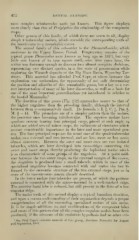Page 462 - My FlipBook
P. 462
472 DENTAL ANATOMY.
most complex trituberciilar teeth yet known. This figure displays
more clearly than that of Periptych us the relationship of the component
cusps.
Other genera of this family, of which there are seven in all, display
simple tritubercular molars, which resemble the corresponding teeth of
the insectivores to a remarkable extent.
The second family of this sub-order is the Phenacodontkkc , which
continues to the Upper Eocene Period. Fragmentary remains of the
typical genus Phenacodus were known as long ago as 1873, but very
little was known of its true nature until, some nine years later, the
writer was fortunate enough to discover two almost complete skeletons,
representing two distinct species, in a fine state of preservation while
exploring the AVasatch deposits of the Big Horn Basin, AVvoming Ter-
ritory. This material has afforded Prof. Cope, at whose instance the
exploration was undertaken, the opportunity of not only determining
the position and affinities of this remarkable genus, but a key to a cor-
rect interpretation of" many of his later discoveries, as well as a basis for
one of the most important generalizations yet introduced in relation to
the hooted Mammalia.^
The dentition of this genus (Fig. 252) approaches nearer to that of
the higher ungulates than the preceding family, although the interval
between them is comparatively small. Its formula is 1. 1^, C \, Pm.
^,
M. 1^ = 44. The premolars are of a simpler pattern than the molars,
the posterior ones becoming tritubercular. The superior molars have
quadrate crowns bearing four principal cusps, placed at each angle, tg
which are added several minor cusps, the rudiments of structures which
assume considerable importance in the later and more specialized gen-
era. The four principal cusps are the usual ones of the quadritubercular
molar, two external and two internal, and are low, more or less conic,
obtuse structures. Between the outer and inner ones are two isolated
tubercles, which are later developed into cross-ridges connecting the
outer and inner cusps, thereby producing the lophodont molar which
is so characteristic of some groups of the ungulates. At a point mid-
way between the two outer cusps, on the external margin of the crown,
the cingulum is produced into a small tubercle, which in most of the
specialized ungulates becomes connected with and unites the two Vs
formed by the crescentic structure of the two external cusps, just as in
some of the insectivorous genera already described.
In the lower molars four tubercles are present, of which the postero-
external is connected with the antero-internal by a well-marked ridge.
The anterior basal lobe is reduced, but still present in the form of a low
cingular ridge.
The molar teeth of this animal display a tyjiical bunodont dentition,
and upon a correct understanding of their organization depends a proper
com]>rehension of all the succeeding s]iecialized molars of this series.
It is l)y sini])le additions to, and modifications of, the component lobes
and crests of this pattern that all the comiilex ungulate molars have been
produced; if the advocate of the evolution hypothesis had no other evi-
' See Prof. Cope's valuable memoir of this group, American Naturolkt for August
and September, 1884.


